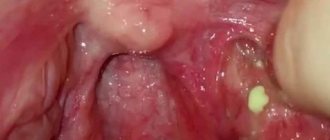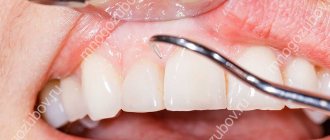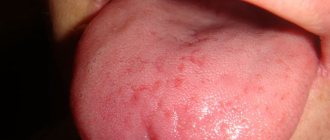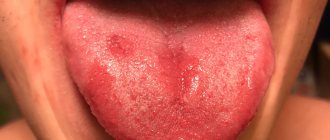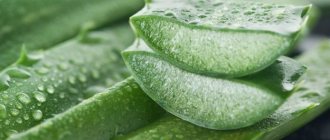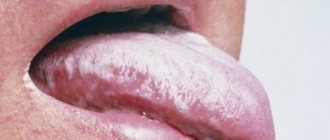When to panic and run to the doctor if you find a green coating
In the morning, almost all people develop a small white-yellow coating on the tongue, which disappears after hygienic cleaning of the oral cavity. If this does not happen and the plaque is difficult to remove, dense, and of an uncharacteristic color, you should consult a doctor. This symptom can appear in an adult, a child, and even an infant. The tongue can have absolutely any color - from white to black, and sometimes even green. Such plaque on the tongue in adults and children most often occurs due to fungal infections, as well as as a consequence of natural aging of the body, HIV infection, diabetes mellitus or cancer. Read more about what this symptom means, why it occurs and how to treat it in today’s material.
Diagnostics
Before a full examination is scheduled, the doctor examines the oral cavity using special medical instruments - a spatula. By the way the greenish coating looks and the enlarged taste buds of the tongue, by the relief surface of the muscular organ, as well as by the thickness of the accumulations and their location, it is not difficult for an experienced doctor to understand the causes of the unpleasant phenomenon. In addition, doctors often prescribe general tests, ultrasound and FGDS.
Adults should initially consult a therapist; children should be shown to a pediatrician. If necessary, patients are referred to the following specialists:
- Gastroenterologist;
- Dentist;
- Infectious disease specialist;
- Otolaryngologist;
- Pulmonologist;
- Endocrinologist;
- Toxicologist;
Such manipulation as removing plaque is very important. This prevents the development of pathogenic microflora and ensures healthy oral mucosa. By the way, clean crowns prevent the appearance of caries - another provoking factor for the appearance of accumulations on the tongue.
What does pathological plaque on the tongue look like?
Before deciding what a coated tongue means and what it is talking about, that is, before making a final diagnosis, the specialist needs to carefully examine the patient’s oral cavity, and also take into account all the accompanying symptoms and complaints. A slight yellowish coating is not a reason to worry. Its formation may be associated with natural physiological processes occurring in the body. If the surface of the tongue has acquired a greenish tint, you should consult a doctor. Perhaps it is a matter of some hidden pathology. Thus, plaque may differ in the following characteristics:
- color, its intensity (we repeat that the norm is a white or slightly yellowish, easily detachable coating),
- consistency (oily, dry, curdled),
- thickness,
- localization.
Why might there be a green coating on the tongue?
What can this mean if a patient has a greenish film on his tongue and a fever? Most often, such symptoms indicate the development of an infectious process in the body. In any case, it is better to immediately consult a doctor so that he can detect the problem at an early stage and offer timely treatment.
Types of plaque
When assessing the nature of the phenomenon, it is worth taking into account not only the amount of deposits, but also their color and structure. Below we will tell you what the color of the plaque says:
- white. A thin white mucous coating after night is not a deviation. An increase in the density of the membrane indicates chronic constipation. A cheesy light coating is a symptom of Candida infection.
- red. Indicates the development of an infection, such as a sore throat. A dark red tint will indicate problems with the kidneys; the plaque acquires this color when the body is poisoned by various poisons;
- yellow. A bright color indicates the development of hepatitis A. If there are problems with the gallbladder, in addition to the yellow film, cracks appear on the tongue;
- green. Visualized during inflammation of the organ - glossitis. Most often, the provoking factor is a fungal infection (yeast glossitis);
- brown. This purulent tint is associated with liver intoxication (alcohol addiction). However, coffee, tea, and chocolate can also give brown color to deposits;
- grey. A characteristic symptom of pathologies of the stomach and duodenum, and also appears when the immune system is damaged. The same diseases also affect tooth enamel (it also takes on a dark shade);
- bluish. This is a symptom of an experienced smoker. The root of the tongue becomes blue and becomes slightly thicker;
- orange. A rare phenomenon that indicates the release of acid from the stomach into the oral cavity. However, this condition should not be confused with staining the surface of the organ with food coloring;
- black. A dangerous sign indicating a strong sludge in the body or a specific disease, for example, Crohn's disease. Black spots on the tongue are visualized due to metal intoxication.
A spotted coating on the tongue (when the surface of the organ is covered with uneven spots) appears in people of different age categories. Most often, this condition does not pose any danger and goes away on its own. Today, the reason for this phenomenon has not been fully identified. Each clinical case is individual - the cause of the spots can be either candidal stomatitis and allergies, or the individual characteristics of the patient’s body.
Why does the symptom occur?
So, now let’s figure out why a suspicious green coating forms on the surface of the tongue of a child or adult. The cause of this symptom is most often associated with certain disturbances in the functioning of individual organs or internal systems:
- decreased immunity and, as a consequence, the body’s vulnerability to attack by pathogenic bacteria, or more precisely, fungi,
- improper functioning of the gastrointestinal tract, increased stomach acidity,
- irritating toothpastes and rinses,
- food products containing dyes,
- smoking,
- tongue injuries, including piercings,
- pregnancy,
- taking certain medications: hormone replacement therapy, oral contraceptives, certain antibiotics and corticosteroids.
This is what a fungal infection on the tongue looks like
“This morning I discovered green spots on my one-year-old son’s tongue. We made an appointment with the pediatrician. The doctor examined him. It turned out that antibiotics weakened the baby’s immunity. A month ago we suffered from pneumonia. The pediatrician told me to treat my mouth with a special solution.”
Yulia Egorova, 28 years old. Tobolsk
Self-examination
Parents can assess the condition of their child’s tongue at home. To conduct a quality diagnosis, adults should adhere to some rules:
Aphthous stomatitis in infants and its treatment
- examine the baby in daylight;
- examine the entire surface of the speaking organ, including the lateral zones, root and hyoid part;
- pay attention to the shape, color and relief of the tongue, as well as the degree of expression of its papillae.
Parents should tell the doctor about all identified signs. In addition to assessing the condition of the tongue, parents should examine the oral cavity of a child over 2 years old once a week for timely detection of carious lesions.
Types and associated manifestations
As part of the diagnosis, the specialist must take into account the main characteristics - first of all, the color and intensity of manifestations. Conventionally, several varieties of green plaque can be distinguished, depending on the shade, location and accompanying symptoms. Let's look at these types in more detail.
White with light green spots
A small thickness of plaque is normal. This color may appear during hot weather due to loss of moisture and dehydration. If the tongue is covered with a dense white film, the patient most likely has hyperthermia (high temperature), which indicates an inflammatory process. A sore throat combined with a symptom can trigger an upper respiratory tract infection.
Streptococcal and staphylococcal infections give rise to a white-green coating on the tongue and the presence of viscous, purulent contents on the surface of the tonsils and in the maxillary sinuses. Oral candidiasis is caused by yeast fungi of the genus Candida and also leads to the formation of a white-green plaque1.
White coating with light green spots
Yellow-green or gray-green
This symptom may be a consequence of a recent inflammatory disease of the ENT organs. Yellow-green or gray-green plaque appears in the following cases:
- pathologies of the liver and gall bladder (hepatitis, cholecystitis),
- diseases of the stomach and intestines (gastritis, gastric ulcer, duodenal ulcer, colitis),
- pathology of the duodenum (pancreatitis),
- diseases of the adrenal glands and kidneys,
- pulmonary pathologies.
Yellow-green coating on the tongue
If the color of the surface of the tongue changes and a light green coating appears, it is better to see a doctor immediately. Timely diagnosis will allow you to identify pathology at an early stage, and therefore quickly cure it.
Dark green coating
This is one of the signs of severe functional disorders of the digestive system (GIT). If nausea, vomiting, diarrhea, or general intoxication occurs, urgent assistance from an infectious disease specialist is required.
If the dark green coating is accompanied by a burning sensation, as well as growth and enlargement of the taste buds, a so-called “hairy” tongue can be diagnosed, which most often becomes a consequence of poor hygiene, dehydration, radiation therapy, long-term use of antibiotics, and too frequent consumption of coffee , tea and smoking.
Dark green coating on the tongue
Green-brown and black-green
Green-brown plaque indicates dangerous and severe pathologies of the hematopoietic system. With complicated infectious lesions of the intestines, in particular with cholera, dehydration occurs catastrophically quickly: the blood thickens, the intensity of saliva production decreases, and the black-green coating on the tongue thickens. In the absence of the necessary treatment, everything can end in death.
Green-brown coating on the tongue
Symptoms
In addition to the unsightly appearance of the tongue, the disease may be accompanied by other symptoms. Their presence depends on the cause of the disease.
- Unpleasant odor from the mouth;
- Pain when eating food and drinks;
- Metallic taste in the mouth;
- Nausea, vomiting;
- A sore throat;
- Inflammation of the tongue.
Such symptoms help determine the cause of the disease.
How is diagnosis carried out: we establish the exact cause of the pathology
Self-diagnosis is ineffective - only a specialist can make the correct diagnosis. The therapist or dentist will conduct a visual examination and pay attention to the shade, density and volume of pathological deposits. For in-depth diagnostics, the doctor will prescribe tests and refer you to specialized specialists. You may need to take a clinical blood and urine test, an immunogram, an HIV test, as well as kidney tests to detect kidney inflammation and adrenal dysfunction.
After examination, the otolaryngologist prescribes bacterial culture of the oral mucosa for microflora and sensitivity to antibiotics. If inflammation is confirmed, the specialist will prescribe a course of antibiotic therapy for at least 7-10 days. An x-ray diagnosis of the paranasal sinuses may also be required to rule out sinusitis and sinusitis.
The gastroenterologist prescribes a biochemical blood test, fibrogastroscopy (FGS) with sampling of gastric juice, duodenal intubation and bile sampling, sigmoidoscopy to exclude ulcerative colitis. The results of these tests will help to exclude the presence of gastritis, gastric and duodenal ulcers, and diagnose hepatitis and bile duct dyskinesia. An abdominal ultrasound may also be prescribed. In severe cases, it is necessary to diagnose vascular pathologies, infectious diseases with similar symptoms and exclude cancerous tumors.
Danger
There is no need to worry when your tongue turns yellow in the following cases:
- Parents should be alerted to plaque that does not go away for a long time
when staining the mucous membranes and tissues in the oral cavity after consuming products with a coloring effect;
- if oral hygiene is not maintained;
- overeating food, in particular saturated fat;
- after taking medications.
This yellowness disappears after several procedures of cleaning the teeth and the mucous membrane with a special brush.
Parents should be alerted to plaque that does not go away for a long time, especially if other symptoms characteristic of the disease also appear.
This may be increased body temperature, nausea, gag reflex, frequent attacks of heartburn, decreased appetite, and abdominal pain. In this case, it is worth paying attention to the structure of the layer and its shade.
A thick, dense coating with a large localization zone and a green or dark brown tint does not bode well.
When examining the tongue, you can pay attention to the localization of the plaque.
Each place signals disturbances in the functioning of certain organs:
- if yellowness is concentrated on the back of the tongue, there is reason to suspect problems with the intestines;
- a yellow tip indicates a heart problem;
- an uneven plaque with cracks forms on the midline due to gastritis and ulcers;
- the extreme posterior points on the tongue indicate kidney dysfunction;
- coating of the front part and along the edges indicates diseases of the respiratory system;
- when diagnosing the spleen, yellowness is noted on the right, and liver problems are read on the left side;
- plaque over the entire surface with uneven coverage is a signal of decreased immunity.
Green coating on the tongue - how to treat it
The treatment process can be short-term in the presence of easily correctable conditions. It will take more time to identify the pathology. Treatment methods in this case include the following:
- regular and high-quality oral hygiene (brush your teeth and tongue, rinse your mouth after every meal),
- rinsing with “Chlorhexidine”, “Chlorophyllipt”, “Furacilin”, “Miramistin”. The drugs are used according to the instructions,
- using a special scraper to clean the tongue,
- normalization of diet and drinking regime - you need to reduce the amount of salt consumed, give up fatty and spicy foods.
Chlorhexidine is often prescribed for the treatment of pathology.
As we have already found out, the phenomenon under consideration is not an independent pathology, but a symptom of disturbances in the functioning of internal organs and systems. Therefore, in order to get rid of the greenish coating once and for all, you need to eliminate the root of the problem.
If you have a fungal infection
As we have already noted, it is a fungal infection that is the main reason for the appearance of green deposits on the tongue. As a rule, it is localized in the oral cavity. Therefore, in such a situation, antibiotics will definitely be prescribed - but, preferably, after passing the appropriate tests. However, you shouldn’t hesitate either - the situation can be dangerous.
The specialist will also prescribe general strengthening and immunostimulating drugs, multivitamin complexes and sorbents, as well as agents that normalize intestinal microflora.
For other pathologies
Here, of course, you need to contact a specialized specialist to prescribe specific treatment - these are various drugs to normalize the functioning of the gastrointestinal tract, compliance with the drinking regime and diet.
Signs
The location of the plaque, its appearance, consistency and thickness are the main signs for the doctor by which he can easily make a diagnosis and determine the main cause of the plaque.
Saturation in color and ease of separation from the tongue may indicate a long-standing sluggish or acute course of the disease. Common signs of plaque include the following:
- Color and shades. The richer and brighter the color, the more extensively the body is affected by the disease.
- Thickness. A weak layer indicates a recent damage to the body, and a thick layer indicates a long-term painful process.
- Consistency. A quickly removable and soft plaque indicates the initial stage of the disease, while dense deposits indicate possible pathologies.
When examining the oral cavity, doctors pay special attention to the location and color of plaque in order to correctly diagnose, identify the causes of changes and prescribe a set of measures to combat them.
Is it possible to treat fibromatosis with folk remedies? We'll tell you in our article. And here you will find out whether there are complications after using conduction anesthesia in dentistry.
Is it possible to use traditional medicine?
To eliminate the symptom (namely, the manifestations, but not the treatment of the underlying disease!) You can use vegetable oil. A small amount should be kept in the mouth for 15 minutes. Then spit it out and clean the surface of the tongue using a brush or a special scraper.
Gargling with medicinal herbs will help in treatment
It is also recommended to rinse your mouth with a decoction of herbs: mint, calendula, St. John's wort. To do this you need to take 15 grams. each of the herbs, brew the mixture in 250 ml of boiling water and let the product brew. You can wipe the surface of the tongue with a soda solution: 2 tbsp. You need to dilute it in 150 ml of water, then moisten a cotton pad or gauze pad in the resulting solution and cleanse it. The procedure should be repeated twice a day.
It is important to immediately note that traditional medicine can only act as a supportive therapy, but not the main one! Do not try to self-medicate, because you can not only aggravate the situation, but also trigger the pathology, bring it to the stage of development when complex and lengthy treatment, possibly even surgery, is required. You can use “grandmother’s” recipes only after agreement with your doctor.
Most common reasons
Let's look at the most common reasons for the appearance of a yellow coating on a child's tongue:
| Yellowness on a child 's tongue | ||
| Cause | Symptoms | Treatment |
| Overeating the night before | Unpleasant sensations in the stomach, heaviness, nausea, dry mouth, yellowish coating on the tongue | A gentle diet, drinking and rest are prescribed. In case of constipation, an enema is recommended. |
| Inflammatory process of the oral cavity | Plaques on the tonsils, formation of aphthae, ulcers. A pronounced yellow coating is localized at the tip of the tongue and in the middle. | Anti-inflammatory drugs are prescribed to eliminate the cause. The plaque goes away as the child recovers with the help of daily oral hygiene. |
| Infectious diseases | High body temperature, vomiting, diarrhea, bleeding cracks in the tongue and yellow-brown coating | First of all, the cause of yellowness in the tongue is eliminated. To remove plaque, it is recommended to follow generally accepted rules of hygiene: brushing your teeth and oral mucosa twice a day, rinsing the cavity after each meal. |
| Jaundice | Yellowing is observed not only on the mucous membrane, but also on the skin and whites of the eyes. In addition, weakness, lethargy, and pain in the right hypochondrium are noted. The coating forms on the mucous membrane of the tip of the tongue and its frenulum, the shade is close to lemon. | A blood test and liver biopsy are performed to determine the exact cause of the disease. Drug treatment is prescribed individually, taking into account the nature of the origin of the disease. The drugs used are: Silibor, Sirepar, Silibinin, etc. Phototherapy is also carried out, and a diet is recommended. When an obstructive form is diagnosed, surgery is prescribed. |
| Gastrointestinal disorders | Symptoms: loss of appetite, nausea, vomiting, pain in the duodenum, heartburn, bad breath. Light yellowness (white-yellow or gray-yellow coating), located in the central part of the tongue. | Conducting drug treatment using drugs: Chamomill, Dioscorea, Magnesia phosphorica, Colocynth, etc. In addition to drugs, a diet rich in minerals and vitamins is developed, and a food intake regimen is established. |
| Insufficient oral hygiene | Yellowness on the tongue, teeth and gums, plaque has a dense structure. | Daily brushing of teeth and the surface of the tongue with toothpaste using a scraper and brush, which is intended for mucous membranes. Mouth rinsing is recommended after every meal. |
| Somatic pathologies | There is intoxication, disruption of the body's metabolic functions and other symptoms characteristic of a particular disease. The tongue is covered with a yellow coating with a slightly brownish tint, localized in a dense layer over almost the entire surface of the tongue. | Patients are prescribed a medicinal course of treatment, which is supplemented by psychotherapeutic influence to regulate the mechanism of development of the disease. A diet is also being developed to strengthen the body’s immune system and saturate it with vitamins. |
Possible causes of a yellow coating on a child’s tongue
The most extensive group of infectious diseases that are characteristic of childhood is considered:
- diphtheria;
- scarlet fever;
- foot and mouth disease;
- whooping cough;
- cholera;
- dysentery, etc.
Yellowing of the oral mucosa can have a different origin; it is not possible to determine the exact cause at home, unless, of course, it is the consumption of food with a coloring effect.
You can assess the situation and prescribe treatment only by understanding why the plaque appeared, after taking tests and performing an ultrasound.
Prevention measures
To minimize any risk of an unpleasant symptom, competent and systematic prevention of diseases of the oral cavity and digestive system should be ensured. In this regard, experts suggest being guided by the following principles:
- double daily brushing of teeth and oral cavity,
- rejection of bad habits,
- normalization of diet and drinking regime,
- use of multivitamin preparations,
- undergoing preventive examinations for early diagnosis of pathologies,
- timely treatment of chronic diseases.
The tongue serves as a kind of indicator of the state of the whole organism. If spots, dense plaque of an unhealthy color, or suspicious growths appear on its surface, you should immediately run to the doctor. The sooner you seek help from a professional, the easier and faster the problem can be resolved.
- Banchenko G.V. Language is the “mirror” of the body: a clinical guide for doctors, 2000.
Treatment options
When a green deposit appears in the mouth, it is not the tongue itself that needs to be treated, but the reason that caused the deposit. First you need to observe the condition of the tongue.
Perhaps the changes on its surface are temporary and associated with the intake of coloring foods. But if the plaque progresses and changes, then you need to consult a specialist. In this case, you cannot self-medicate.
After completing the initial diagnosis, the doctor prescribes medications or additional tests. In this case, therapeutic measures can consist of either a single procedure or a set of measures to restore the body .
Methods of treatment depending on the causes of discoloration of the surface of the tongue:
In case of insufficient oral hygiene
If the tests did not reveal diseases that could contribute to the appearance of a green coating on the tongue, then the reason lies in improper hygiene.
It is necessary to strengthen oral care by using a high-quality toothbrush and toothpaste in hygiene procedures. They should be done every time after a meal. It is very important to brush not only your teeth, but also your cheeks and tongue.
Additionally, you need to use solutions and anti-inflammatory disinfectant rinses.
Such agents can be any dental rinse solution, pharmaceutical preparations (chlorhexidine, furatsilin, potassium permanganate) or soda solutions. They eliminate bacteria and unpleasant odors.
For diseases of the gastrointestinal tract
Greening of the tongue can occur due to diseases in the gastrointestinal tract. These include gastric ulcers, disorders of the pancreas or gall bladder.
In these cases, it is important to consult a specialist and follow all his instructions to avoid complications.
If you need to prevent bile stagnation, you need to drink allochol or similar drugs.
For pathologies of the liver
In this case, it is important to pay attention to your diet and exclude fatty, spicy and highly salty foods from the menu. To maintain liver function, the doctor may prescribe hepatoprotective agents such as Ovesol, Carsil, Essentiale Forte or Ursofalk.
After taking antibiotics or other medications
Antibiotics usually kill not only pathogenic bacteria, but also those beneficial to the human body. To avoid fungal diseases, you need to add drugs rich in beneficial bacteria to this course of treatment.
After taking antibiotics, you need to wait a week or two and have your mouth examined again.
Due to decreased body immunity and lack of vitamins
For effective treatment in this case, it is necessary to improve the quality of nutrition, expand the diet, and include vitamins, vegetables and fruits. It is important to give yourself more time: relax and walk in the fresh air.
For candidiasis or other fungal diseases
When the cause of greenish deposits is a fungal infection, an antifungal course of treatment is used to eliminate it.
Depending on the type of infection, the doctor prescribes fluconazole, nystatin, mycosist or other medications.
Due to bad habits and lifestyle
The main measure to improve the condition of the surface of the tongue will be to quit smoking, alcohol and addictions.
Daily walks in the fresh air, sports activities and a healthy diet will change the health of the whole body for the better.
For HIV infection
The correct treatment in this case is prescribed by the doctor. Preventive and relieving measures, as well as medications, are applied to each patient individually.
For glossitis
Depending on the causes of glossitis, the type of treatment is chosen. For injuries, rinses, applications or baths are used, for exposure to pathogenic microorganisms - anti-inflammatory drugs or antibiotics, and for other diseases - immunocorrectors.
With elevated bilirubin levels
Diseases of the blood, liver or gall bladder are treated, based on the results of which tests are again checked and the condition of the oral cavity is assessed. They check the body for the presence of worms, and also increase the intake of vitamin B12.
In addition to treatment from specialists, you can additionally use traditional medicine, which includes:
- Herbal infusions for oral administration. From the flowers of linden, yarrow, plantain and oregano you can make a remedy for oral administration.
To do this, pour 300 ml of boiling water into about 30 g of herb and let it brew. Next, divide and take three times a day.To generally cleanse the body and improve the functioning of the digestive system, you can brew flax seeds and drink this decoction in the morning before meals.
- Herbal rinses. Using infusions of chamomile, sage and mint, you can rinse your mouth several times a day to eliminate or reduce plaque.
To do this you need to take 3 - 4 tbsp. l. dry herbs, pour boiling water over them and leave for a couple of hours. Strain the infused solution, divide into several parts and use for rinsing. - Soda solutions. Soda solutions can be used to clean the surface of the tongue using cotton swabs or gauze.
Add 2.5 tsp to a glass of warm water. soda and mix, and then moisten the gauze there. This method can be used daily up to four times a day every three months for prevention.
What is dental splinting with fiberglass tape? We will talk about this in detail in our publication. And here it is written what inflammation of the periosteum is.
By clicking on the following link: you will find out when toothache treatment with antibiotics is required.




